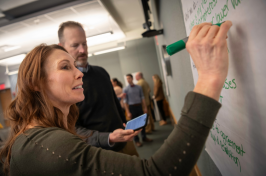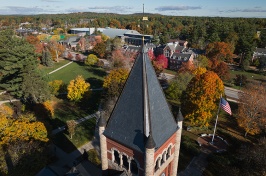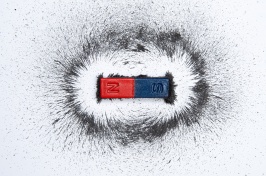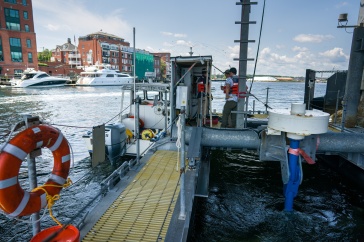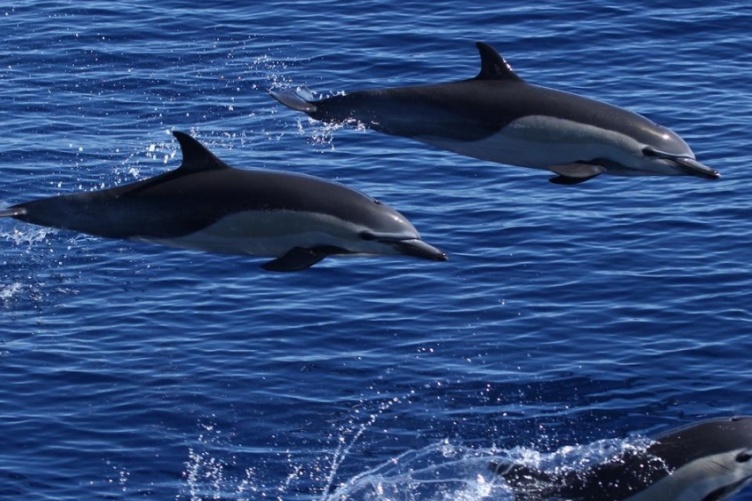
A common dolphin similar to these dolphins that died in the Mill River in Gloucester, Mass., had a parasitic infection and hemorrhage in its brain. Credit: NOAA
Results of a necropsy performed on a dolphin that died in the Mill River in Gloucester, Mass., indicate the animal had a parasitic infection and hemorrhage in its brain, according to a pathologist with the NH Veterinary Diagnostic Lab at UNH. While there is no risk to humans from this parasite, the event underscores warnings that the public never should interact with animals in the wild that could potentially be carrying parasites and diseases that can be transmitted to humans.
“Surveillance of marine mammals–both live and dead–is important, as these animals are sentinels of the health of the marine ecosystem that we share with them. We know diseases can jump species and potentially move from wildlife into domestic animal or human populations, so it’s useful to keep tabs on what’s circulating nearby,” senior veterinary pathologist Inga Sidor said.
The dolphin was submitted to the lab Saturday, Jan. 16, 2021, by its partner, Seacoast Science Center Marine Mammal Rescue, which is the NOAA-designated and approved responder to stranded marine mammals in the New Hampshire and northern Massachusetts seacoast region. The dolphin, which died the day before, was an adult male common dolphin, 330 pounds and almost 8 feet long.
According to Sidor, there was no evidence of major traumatic injuries, and the animal appeared in fair condition, nutritionally. Its stomach and intestines were largely empty, suggesting it had not been well and was not eating. The necropsy revealed a small area of discoloration in the cerebellum, a part of the brain responsible for movement and coordination.
On microscopic exam, eggs of a parasitic fluke worm were associated with the hemorrhage and inflammation at that site. This non-zoonotic parasite, Nasitrema sp., is a relatively common infection of dolphins, porpoises and whales worldwide and is often seen in this region. Migration of the adult worm and the presence of eggs results in local inflammation, which can disrupt echolocation and orientation, leading to stranding.
“As this case has shown, the public is intensely curious about these animals, and even if we are unable to save an individual animal, knowing why it died can create an educational moment. When possible and safe, it’s also a great opportunity for our students to get close to otherwise untouchable animals and learn more about how they’ve evolved to survive in the marine environment, how they’re the same or different from other more familiar animals, and how their populations might be affected by human presence in the oceans,” she said.
The NH Veterinary Diagnostic Lab, which is part of the NH Agricultural Experiment Station, works with marine mammal rescue groups from Maine to Cape Cod. The lab helps to monitor marine mammal populations for outbreaks of infectious disease such as the 2011 seal mortality event in the Gulf of Maine and the 2018 phocine distemper virus, a close relative of canine distemper virus.
The NOAA Greater Atlantic Regional Fisheries office received reports of a free-swimming dolphin in the Mill River on Friday, Jan. 15, 2021, and began monitoring its behavior. Seacoast Science Center’s Marine Mammal Rescue, which partners with NOAA and UNH in these situations, was alerted.
“When we first saw this dolphin, so far out of its normal habitat, we were concerned it was ill or injured. Unlike coastal bottlenose dolphins, common dolphins rarely come into shallow water. They are highly social animals usually found offshore and able to travel great distances. It’s very unusual for one to be alone and so close to shore, although these social animals will leave their groups if they are sick or injured and may seek out a quiet, calm area,” said Mendy Garron, Marine Mammal Response program coordinator for NOAA’s Greater Atlantic region.
Shortly after NOAA began observing the dolphin, officials saw behaviors that indicated the animal was compromised. It stranded on the mud flat and entered what is known as death throes --when the body shuts down prior to death.
“In these situations, we try to balance what we can do for the animal with how much stress we will cause. Common dolphins are extremely sensitive to human intervention and often panic when we try to net or capture them, which can cause them further injury. Based on their experience, trained responders knew that moving this dolphin into deeper water would cause it additional stress since it was seeking shallow water. Unfortunately, this is what happened when caring, but untrained, observers dragged this dolphin into deeper water where the dolphin could not keep its head and blowhole above water. It then died,” Garron said.
“Watching a beautiful wild animal die is sad and painful for all of us, especially the stranding responders who have trained and devoted their careers to helping these animals. Our responders knew, and tried to explain to observers, that there was nothing they could do to help the dolphin, and the best course of action was to let the animal pass on its own. If any intervention would have helped, our responders would have stepped in, but they could tell that the kindest thing to do for this animal was to let it die peacefully,” said Colleen Coogan, marine mammal/sea turtle team lead.
The NH Veterinary Diagnostic Lab serves the state of New Hampshire by providing accessible, timely, and accurate diagnostic services for the New Hampshire Department of Agriculture, Markets, & Food, New Hampshire Department of Health and Human Services, New Hampshire Fish and Game Department, state and local law enforcement agencies, veterinarians, farmers, and other relevant state, regional, and federal agencies. It is co-funded and co-managed by the New Hampshire Department of Agriculture, Markets & Food and the NH Agricultural Experiment Station. The lab has served the state and the university since 1970, working at the junction of animal health, public health, environmental health, and economic health.
Founded in 1887, the NH Agricultural Experiment Station at the UNH College of Life Sciences and Agriculture is UNH’s first research center and an elemental component of New Hampshire's land-grant university heritage and mission. We steward federal and state funding, including support from the USDA National Institute of Food and Agriculture, to provide unbiased and objective research concerning diverse aspects of sustainable agriculture and foods, aquaculture, forest management, and related wildlife, natural resources, and rural community topics. We maintain the Woodman and Kingman agronomy and horticultural research farms, the Macfarlane Research Greenhouses, the Fairchild Dairy Teaching and Research Center, and the Organic Dairy Research Farm. Additional properties also provide forage, forests, and woodlands in direct support to research, teaching, and outreach.
The University of New Hampshire is a flagship research university that inspires innovation and transforms lives in our state, nation, and world. More than 16,000 students from all 50 states and 71 countries engage with an award-winning faculty in top ranked programs in business, engineering, law, liberal arts, and the sciences across more than 200 programs of study. UNH’s research portfolio includes partnerships with NASA, NOAA, NSF, NIH, and USDA, receiving more than $100 million in competitive external funding every year to further explore and define the frontiers of land, sea, and space.
-
Written By:
Lori Tyler Gula, Ph.D., '19 | NH Agricultural Experiment Station | lori.gula@unh.edu | 603-862-1452












